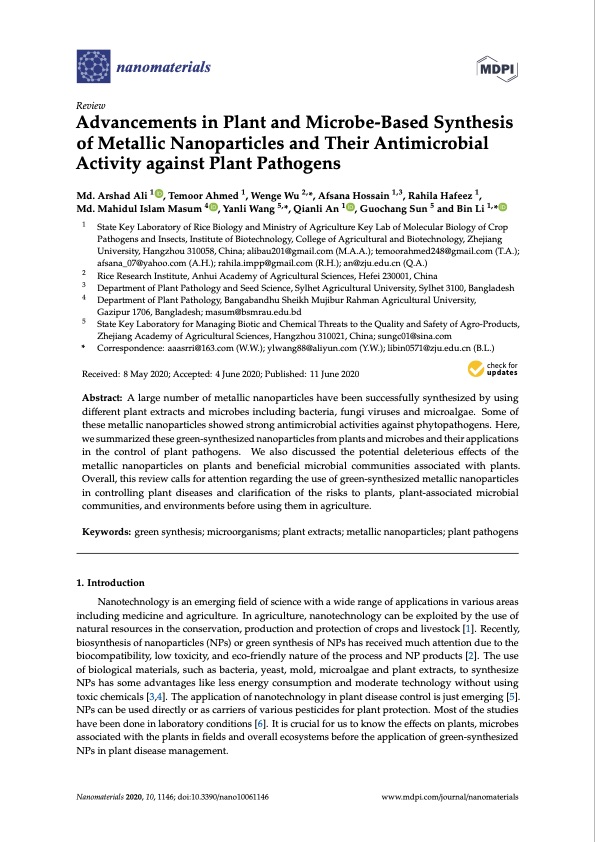
PDF Publication Title:
Text from PDF Page: 001
nanomaterials Review Advancements in Plant and Microbe-Based Synthesis of Metallic Nanoparticles and Their Antimicrobial Activity against Plant Pathogens Md. Arshad Ali 1 , Temoor Ahmed 1, Wenge Wu 2,*, Afsana Hossain 1,3, Rahila Hafeez 1, Md. Mahidul Islam Masum 4 , Yanli Wang 5,*, Qianli An 1 , Guochang Sun 5 and Bin Li 1,* 1 2 3 4 State Key Laboratory of Rice Biology and Ministry of Agriculture Key Lab of Molecular Biology of Crop Pathogens and Insects, Institute of Biotechnology, College of Agricultural and Biotechnology, Zhejiang University, Hangzhou 310058, China; alibau201@gmail.com (M.A.A.); temoorahmed248@gmail.com (T.A.); afsana_07@yahoo.com (A.H.); rahila.impp@gmail.com (R.H.); an@zju.edu.cn (Q.A.) Rice Research Institute, Anhui Academy of Agricultural Sciences, Hefei 230001, China Department of Plant Pathology and Seed Science, Sylhet Agricultural University, Sylhet 3100, Bangladesh Department of Plant Pathology, Bangabandhu Sheikh Mujibur Rahman Agricultural University, Gazipur 1706, Bangladesh; masum@bsmrau.edu.bd State Key Laboratory for Managing Biotic and Chemical Threats to the Quality and Safety of Agro-Products, Zhejiang Academy of Agricultural Sciences, Hangzhou 310021, China; sungc01@sina.com 5 * Correspondence: aaasrri@163.com (W.W.); ylwang88@aliyun.com (Y.W.); libin0571@zju.edu.cn (B.L.) Received: 8 May 2020; Accepted: 4 June 2020; Published: 11 June 2020 Abstract: A large number of metallic nanoparticles have been successfully synthesized by using different plant extracts and microbes including bacteria, fungi viruses and microalgae. Some of these metallic nanoparticles showed strong antimicrobial activities against phytopathogens. Here, we summarized these green-synthesized nanoparticles from plants and microbes and their applications in the control of plant pathogens. We also discussed the potential deleterious effects of the metallic nanoparticles on plants and beneficial microbial communities associated with plants. Overall, this review calls for attention regarding the use of green-synthesized metallic nanoparticles in controlling plant diseases and clarification of the risks to plants, plant-associated microbial communities, and environments before using them in agriculture. Keywords: green synthesis; microorganisms; plant extracts; metallic nanoparticles; plant pathogens 1. Introduction Nanotechnology is an emerging field of science with a wide range of applications in various areas including medicine and agriculture. In agriculture, nanotechnology can be exploited by the use of natural resources in the conservation, production and protection of crops and livestock [1]. Recently, biosynthesis of nanoparticles (NPs) or green synthesis of NPs has received much attention due to the biocompatibility, low toxicity, and eco-friendly nature of the process and NP products [2]. The use of biological materials, such as bacteria, yeast, mold, microalgae and plant extracts, to synthesize NPs has some advantages like less energy consumption and moderate technology without using toxic chemicals [3,4]. The application of nanotechnology in plant disease control is just emerging [5]. NPs can be used directly or as carriers of various pesticides for plant protection. Most of the studies have been done in laboratory conditions [6]. It is crucial for us to know the effects on plants, microbes associated with the plants in fields and overall ecosystems before the application of green-synthesized NPs in plant disease management. Nanomaterials 2020, 10, 1146; doi:10.3390/nano10061146 www.mdpi.com/journal/nanomaterialsPDF Image | Plant and Microbe-Based Synthesis of Metallic Nanoparticles

PDF Search Title:
Plant and Microbe-Based Synthesis of Metallic NanoparticlesOriginal File Name Searched:
nanomaterials-10-01146.pdfDIY PDF Search: Google It | Yahoo | Bing
Turbine and System Plans CAD CAM: Special for this month, any plans are $10,000 for complete Cad/Cam blueprints. License is for one build. Try before you buy a production license. More Info
Waste Heat Power Technology: Organic Rankine Cycle uses waste heat to make electricity, shaft horsepower and cooling. More Info
All Turbine and System Products: Infinity Turbine ORD systems, turbine generator sets, build plans and more to use your waste heat from 30C to 100C. More Info
CO2 Phase Change Demonstrator: CO2 goes supercritical at 30 C. This is a experimental platform which you can use to demonstrate phase change with low heat. Includes integration area for small CO2 turbine, static generator, and more. This can also be used for a GTL Gas to Liquids experimental platform. More Info
Introducing the Infinity Turbine Products Infinity Turbine develops and builds systems for making power from waste heat. It also is working on innovative strategies for storing, making, and deploying energy. More Info
Need Strategy? Use our Consulting and analyst services Infinity Turbine LLC is pleased to announce its consulting and analyst services. We have worked in the renewable energy industry as a researcher, developing sales and markets, along with may inventions and innovations. More Info
Made in USA with Global Energy Millennial Web Engine These pages were made with the Global Energy Web PDF Engine using Filemaker (Claris) software.
Infinity Turbine Developing Spinning Disc Reactor SDR or Spinning Disc Reactors reduce processing time for liquid production of Silver Nanoparticles.
| CONTACT TEL: 608-238-6001 Email: greg@infinityturbine.com | RSS | AMP |